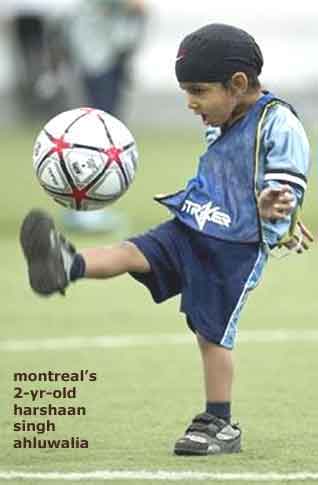Sports
The Falsehoods Behind Quebec's Disastrous Turban & Patka Ban
DON MACPHERSON
Before the directors of the Quebec soccer federation are allowed to forget their disastrous dabbling in identity politics over the Sikh patka and turban, it’s worth remembering that their position, and that of their supporters, was based on two falsehoods.
It’s worth remembering because the second of the two falsehoods will probably be repeated in the fall, when the Parti Québécois government proposes its “charter of Quebec values.”
The first falsehood was told by the Federation.
It was that it could defy an order by the sport’s Canadian governing body -- that it allow male Sikh players to wear the turban and other religious head coverings -- because head coverings were not yet allowed by the international soccer federation, FIFA.
That falsehood was exposed on Saturday, June 15, 2013) in a report by Radio-Canada that the Quebec federation knew when its directors voted June 1, 2013 to uphold the ban on the turban that FIFA did allow the Sikh head coverings. The television report showed documents that it said proved the federation knew last September that FIFA had already ruled in favour of the turban.
The most damning evidence in the report, however, was an admission by the Federation’s director that it officially “heard of” FIFA’s ruling in April -- nearly two months before its directors voted to uphold their ban.
The second falsehood was the argument of the Federation’s supporters that “reasonable accommodations” of minority religions, such as allowing the patka and turban in soccer, are based on an anti-French policy imposed on Quebec by English Canada.
That policy would be Canadian multiculturalism: respecting and preserving the country’s minority cultures. It was introduced in the early 1970s to try to overcome resistance to official bilingualism, which detractors argued favoured only French-Canadians -- a minority that in some parts of the country, in Western Canada especially, was smaller than other ethnic groups.
French-Canadians saw multiculturalism as detracting from Canada’s founding principle of French-English linguistic duality. Also, the “preservation and enhancement of the multicultural heritage of Canadians” is enshrined in the 1982 Charter of Rights and Freedoms, which was imposed on Quebec over the objection of its legislature.
“Reasonable accommodations,” however, aren’t based on multiculturalism.
The association of “reasonable accommodations” with religious minorities was popularized in this province by a controversial 2006 judgment by the Supreme Court of Canada. The ruling allowed a Quebec Sikh boy to wear his kirpan to school.
The 8-0 decision was based not on the charter’s multiculturalism clause, but on freedom of religion. That freedom is protected not only by the Canadian charter, but also by Quebec’s own Charter of Human Rights and Freedoms. And the latter was adopted in 1975 -- seven years before the Canadian charter.
Also, the conditions under which the boy was allowed to wear his kirpan to school originated with the boy’s French-language school board. And they were expanded in an initial ruling by a French-speaking judge of Quebec Superior Court.
So “reasonable accommodations” are as much a Quebec value as they are a Canadian one. Or at least they should be.
The province’s political class, however, increasingly sees the Quebec charter as a nuisance preventing the majority from imposing its language and values on the minorities.
Still, it is easier politically for opponents of religious accommodations to ignore the Quebec charter and instead attack the accommodations as the product of Canadian multiculturalism.
It’s a falsehood, but one we’ll probably hear again in the fall, in support of the PQ’s “values” charter.
[Courtesy: The Montreal Gazette]
June 20, 2013



